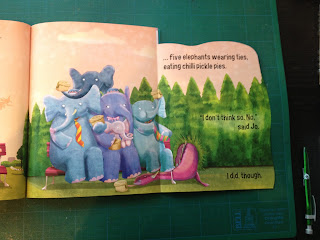A
lot of us are lucky enough to remember the joy of sitting snug in bed as a
parent read us a bedtime picture book, and also know the joy of being that
adult performing the picture book text for an eager child audience. Those of us in the book world tend to have
taken that relationship between an adult reading the text to a child who is
looking carefully at the pictures while they listen for granted.
But there are many adults who find reading hard. What if the adult can’t read the text? Can’t enjoy that bond that comes from reading and sharing a book with their children?
In recent years there has been a lot of work done to create what are known as high/low books (higher age interest level together with a lower age reading ability) to help children and adults who struggle to read books to themselves. But nobody had given much thought to the parents who want to read to their children but find reading picture books out loud too much of a challenge.
Designers often play with text in picture books, working it through illustrative images, varying font size and style to make it express the text meaning, sometimes expecting the reader to jump from text at the top of a spread to text at the bottom, then up to the top of the facing page. All those things can work well for the able reader, but they become obstacles to reading if you are somebody who finds reading hard, perhaps because you are dyslexic and never learned to read fluently at school, perhaps because English isn’t your first language.
So Barrington Stoke have come up with a series of picture books that are designed to be read easily by children and adults alike. What makes them easier to read?
- Pages that are a tinted cream background rather than the stark white that can make reading hard if you’re dyslexic.
- Text laid out left to right, top to bottom.
- A font that is clear, reader-friendly, and consistent.
- Writing that doesn’t introduce made-up strange words that have to be worked out.
Does any of that that mean that these are dull books? Far from it!
These are rather sophisticated picture books, aimed at children of, say, seven plus. Their stories challenge in a way that you might not want a book for the usual picture book audience of 2-5 year olds to be challenged.
‘All
I Said Was’, by Michael Morpurgo and Ross Collins is a short tale, showing and
telling how a boy who swapped his life for that of a pigeon begins to regret
that swap when he gets mobbed by crows … but when he returns home, the pigeon
who is now a boy won’t swap back. Rather
as the child in Roald Dahl’s Witches is left stuck as a mouse at the end of
that book, this book too leaves a bleak and seemingly hopeless ending for the
boy. Food for thought, and a bit of thrilling
horror, all in twelve spreads of illustration and a short text!
‘Wolf Man’ by Michael Rosen and Chris Mould plays with fear as a scary manic-looking Wolfman runs amok through a town, scaring even the army and the chief of police … until the tension is brilliantly cut with a typical Michael Rosen joke of a kind which children will find hilarious! This book has slash marks, and real holes, in it’s cover, presumably made by the Wolfman’s claws. Books can be exciting!
There are more of these Picture Squirrel books out there, all combining top illustrators and writers, all of them quality books. Hooray that one publisher has woken up to the need for excellent accessible picture books for parents and children to share.
Do look at this whole series of books and more on the Barrington Stoke website by clicking here


























